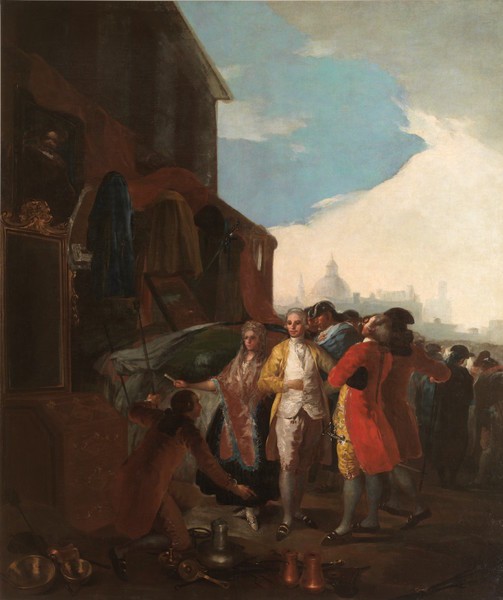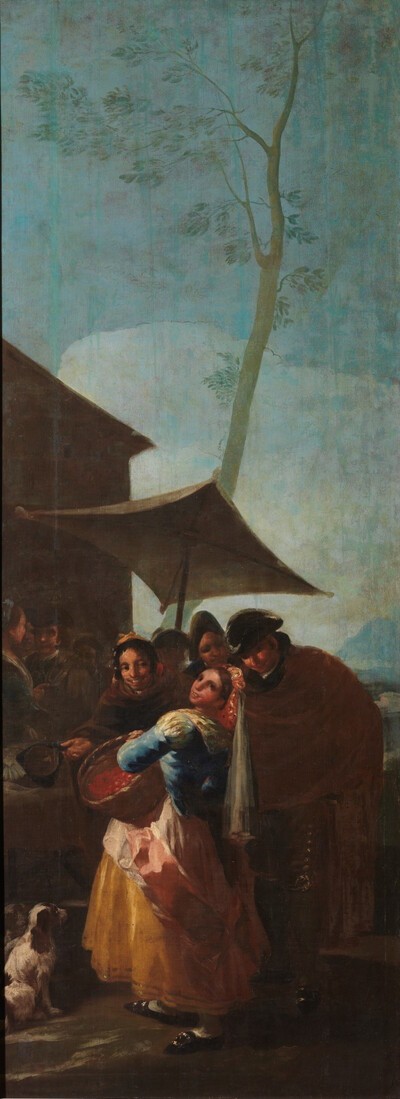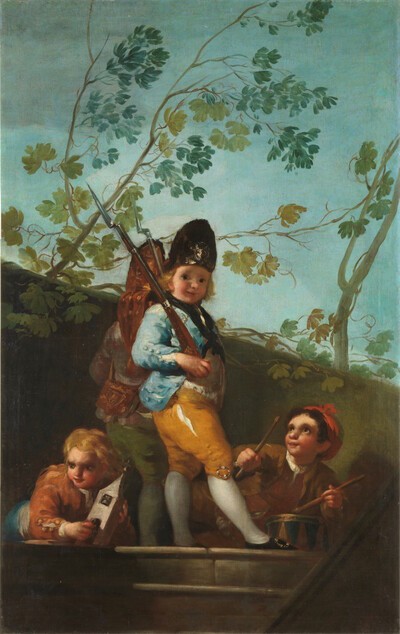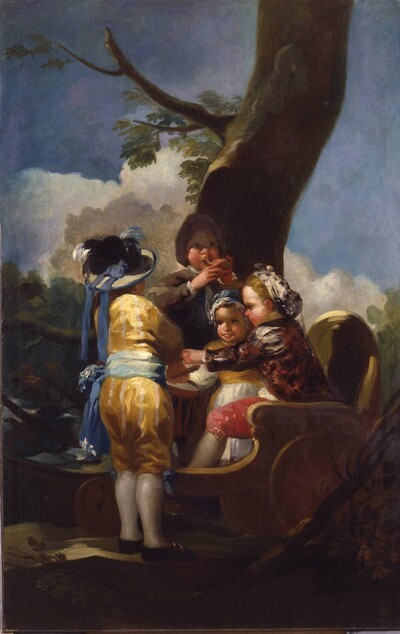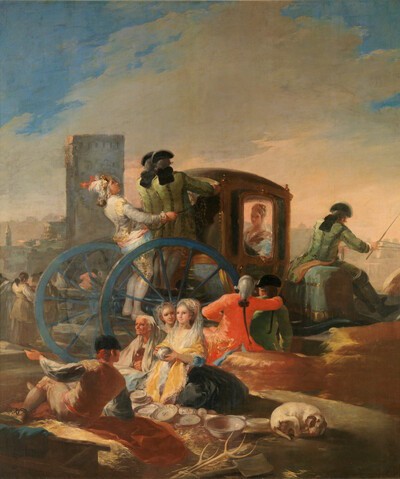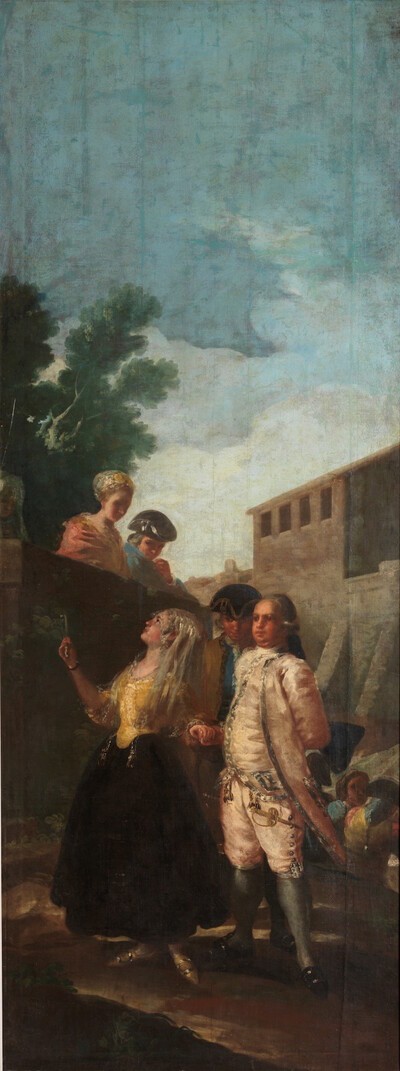- Cronología
- 1778 - 1780
- Ubicación
- The Prado National Museum. Madrid, Madrid, Spain
- Dimensiones
- 258 x 218 cm
- Técnica y soporte
- Oil on canvas
- Reconocimiento de la autoría de Goya
- Documented work
- Titular
- El Prado National Museum
- Ficha: realización/revisión
- 22 Nov 2009 / 14 Jun 2023
- Inventario
- (P00779)
This work forms part of the series of seven cartoons on the theme of the fair for tapestries designed to decorate the bedroom of the Prince and Princess of Asturias in the palace of El Pardo.
On 2 October 1777, Goya was sent two lists with the dimensions of the tapestries that were to decorate the royal chambers. The first contained seven pieces for the bedroom itself and the second listed thirteen to be hung in the antechamber.
On 6 January 1779, Goya delivered an invoice to the Royal Tapestry Factory for six new cartoons: The Fair at Madrid, The Pottery Vendor, The Soldier and the Lady, The Haw Seller, Boys Playing at Soldiers and Children with a Cart. A seventh cartoon, that of The Blind Guitarist, the tapestry of which was also to form part of the decorative scheme of the bedroom but which ended up being displayed in the antechamber to the bedroom, was delivered to the factory on 27 April 1778. We must assume that the six aforementioned cartoons were made during the period between the two deliveries of 27 April 1778 and 6 January 1779. A letter from Goya to his friend Martín Zapater dated 9 January mentions "four paintings" that were particularly well received by Charles III and the Prince and Princess of Asturias. The letter does not specify which ones they were but, given that the delivery was made just three days before Goya wrote this letter, it is very likely that he was referring to some of the works in this series. It is no surprise that the paintings pleased their Majesties, since the theme of Spanish types was a favourite among the ilustrados.
Around 1856 or 1857, the cartoon was moved from the Royal Tapestry Factory of Santa Bárbara to the Royal Palace in Madrid. In 1870, it was taken to the Prado Museum under orders given on 18 January and 9 February.
The tapestry of The Fair at Madrid would have hung on the east wall of the royal bedroom, opposite that of The Pottery Vendor.
It is one of Goya's most acclaimed cartoons. It depicts a scene in which a nobleman and woman are entering the fair and are looking at the stand of an antiques dealer. They are accompanied by a connoisseur, who is peering attentively up at the paintings through his spectacles. The iridescent highlights on the gentleman's clothes and the fine detail on the lady's shawl are very worthy of attention, along with the skilfully rendered metals in the still life that is spread out in the foreground. All of these effects would have been difficult to transfer to the tapestry. In contrast to the strong light falling on the elegant couple, the antiques dealer is deftly painted against the light.
In the background, subtly standing out against the afternoon sky, is the outline of the dome of the church of San Francisco el Grande. This landmark, which appears again and again in the works of Goya, was newly built at the time, having been finished only shortly before 1777.
The scene is set on the traditional site of the city's annual fair, where the Rastro flea market is held today, in Madrid's Ribera de Curtidores and Plaza de la Cebada.
The reddish preparation that Goya applied, sometimes covered with a thin glaze, has caused the work to darken over the years. Its colours now appear flat and lack the tonal range that they would have had originally.
-
Les chefs-d’œuvre du Musée du PradoMusée d’Art et d’HistoireGeneva1939consultant editors Fernando Álvarez de Sotomayor y Pedro Muguruza Otaño. From June to September 1939cat. 36
-
GoyaPalacio de PedralbesBarcelona1977from April 12th to June 30th 1977cat. 18
-
Goya. 250 AniversarioMuseo Nacional del PradoMadrid1996consultant editor Juan J. Luna. From March 29th to June 2nd 1996cat. 18
-
Permanencia de la memoria, cartones para tapiz y dibujos de GoyaMuseo de ZaragozaZaragoza1997organized by Gobierno de Aragón, Museo Nacional del Prado and Patrimonio Nacional, consultant editor Fernando Checa Cremades. From February 14th to April 6th 1997cat. 9, sec. IV
-
Goya luces y sombrasCaixaForumBarcelona2012consultant editors José Manuel Matilla and Manuela B. Marqués. From March 16th to June 24th 2012cat. 7
-
L'œuvre peint de Goya. 4 volsParís1928-1950vol. I, p. 71, cat. 12
-
Tapices de GoyaMadridPatrimonio Nacional1946pp. 103, 110, 220, cat. 21 y láms. 95-97
-
Vie et ouvre de Francisco de GoyaParísOffice du livre1970pp. 76, 88, cat. 124
-
BarcelonaPolígrafa1970vol. I, p. 247, cat. 74
-
L’opera pittorica completa di GoyaMilanRizzoli1974p. 95, cat. 81
-
Francisco de Goya, 4 vols.ZaragozaCaja de Ahorros de Zaragoza, Aragón y Rioja1980-1982vol. I, p. 97 y p. 145 (il.)
-
Francisco de Goya, cartones y tapicescol. col. "Espasa Arte"Espasa Calpe1987pp. 93, 95, 264, cat. 25C y p. 95 (il.)
-
Francisco de Goya. Los cartones para tapices y los comienzos de su carrera en la corte de Madridcol. col. "Ensayos de Arte Cátedra"MadridCátedra1987pp. 103, 104 y p. 100 (il.)
-
Goya. 250 AniversarioMadridMuseo del Prado1996pp. 298-300, cat. 18 y p. 90 (il.)
-
Salas del Palacio Real de El Pardo para las que se tejieron tapices sobre cartones de Francisco de Goya: identificación de las habitaciones y ajuste de las obras de Goya en los alzados de las paredesin HERRERO CARRETERO, Concha (curator, Tapices y cartones de Goya (catalogue of the exhibition organizated at the Palacio Real de Madrid, from may to june 1996)MadridPatrimonio Nacional, Goya 96, Lunwerg1996p. 170 (il.)
-
Cartas a Martín ZapaterMadridIstmo2003p. 72, nº 8
-
Goya en Madrid. Cartones para tapices 1775-1794MadridMuseo Nacional del Prado2014p. 142
